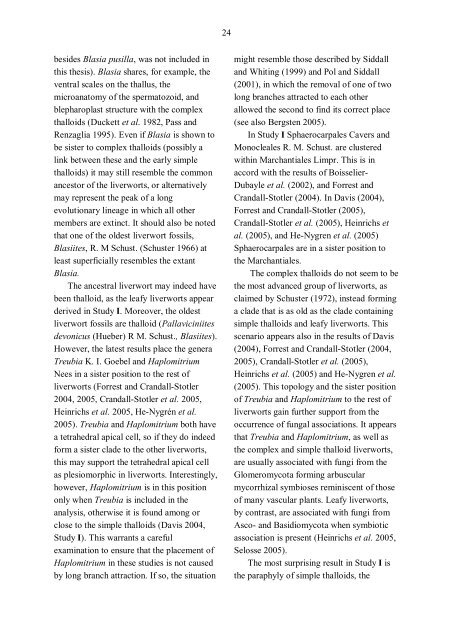Evolutionary relationships of liverworts with a special focus ... - Doria
Evolutionary relationships of liverworts with a special focus ... - Doria
Evolutionary relationships of liverworts with a special focus ... - Doria
You also want an ePaper? Increase the reach of your titles
YUMPU automatically turns print PDFs into web optimized ePapers that Google loves.
24<br />
besides Blasia pusilla, was not included in<br />
this thesis). Blasia shares, for example, the<br />
ventral scales on the thallus, the<br />
microanatomy <strong>of</strong> the spermatozoid, and<br />
blepharoplast structure <strong>with</strong> the complex<br />
thalloids (Duckett et al. 1982, Pass and<br />
Renzaglia 1995). Even if Blasia is shown to<br />
be sister to complex thalloids (possibly a<br />
link between these and the early simple<br />
thalloids) it may still resemble the common<br />
ancestor <strong>of</strong> the <strong>liverworts</strong>, or alternatively<br />
may represent the peak <strong>of</strong> a long<br />
evolutionary lineage in which all other<br />
members are extinct. It should also be noted<br />
that one <strong>of</strong> the oldest liverwort fossils,<br />
Blasiites, R. M Schust. (Schuster 1966) at<br />
least superficially resembles the extant<br />
Blasia.<br />
The ancestral liverwort may indeed have<br />
been thalloid, as the leafy <strong>liverworts</strong> appear<br />
derived in Study I. Moreover, the oldest<br />
liverwort fossils are thalloid (Pallaviciniites<br />
devonicus (Hueber) R M. Schust., Blasiites).<br />
However, the latest results place the genera<br />
Treubia K. I. Goebel and Haplomitrium<br />
Nees in a sister position to the rest <strong>of</strong><br />
<strong>liverworts</strong> (Forrest and Crandall-Stotler<br />
2004, 2005, Crandall-Stotler et al. 2005,<br />
Heinrichs et al. 2005, He-Nygrén et al.<br />
2005). Treubia and Haplomitrium both have<br />
a tetrahedral apical cell, so if they do indeed<br />
form a sister clade to the other <strong>liverworts</strong>,<br />
this may support the tetrahedral apical cell<br />
as plesiomorphic in <strong>liverworts</strong>. Interestingly,<br />
however, Haplomitrium is in this position<br />
only when Treubia is included in the<br />
analysis, otherwise it is found among or<br />
close to the simple thalloids (Davis 2004,<br />
Study I). This warrants a careful<br />
examination to ensure that the placement <strong>of</strong><br />
Haplomitrium in these studies is not caused<br />
by long branch attraction. If so, the situation<br />
might resemble those described by Siddall<br />
and Whiting (1999) and Pol and Siddall<br />
(2001), in which the removal <strong>of</strong> one <strong>of</strong> two<br />
long branches attracted to each other<br />
allowed the second to find its correct place<br />
(see also Bergsten 2005).<br />
In Study I Sphaerocarpales Cavers and<br />
Monocleales R. M. Schust. are clustered<br />
<strong>with</strong>in Marchantiales Limpr. This is in<br />
accord <strong>with</strong> the results <strong>of</strong> Boisselier-<br />
Dubayle et al. (2002), and Forrest and<br />
Crandall-Stotler (2004). In Davis (2004),<br />
Forrest and Crandall-Stotler (2005),<br />
Crandall-Stotler et al. (2005), Heinrichs et<br />
al. (2005), and He-Nygren et al. (2005)<br />
Sphaerocarpales are in a sister position to<br />
the Marchantiales.<br />
The complex thalloids do not seem to be<br />
the most advanced group <strong>of</strong> <strong>liverworts</strong>, as<br />
claimed by Schuster (1972), instead forming<br />
a clade that is as old as the clade containing<br />
simple thalloids and leafy <strong>liverworts</strong>. This<br />
scenario appears also in the results <strong>of</strong> Davis<br />
(2004), Forrest and Crandall-Stotler (2004,<br />
2005), Crandall-Stotler et al. (2005),<br />
Heinrichs et al. (2005) and He-Nygren et al.<br />
(2005). This topology and the sister position<br />
<strong>of</strong> Treubia and Haplomitrium to the rest <strong>of</strong><br />
<strong>liverworts</strong> gain further support from the<br />
occurrence <strong>of</strong> fungal associations. It appears<br />
that Treubia and Haplomitrium, as well as<br />
the complex and simple thalloid <strong>liverworts</strong>,<br />
are usually associated <strong>with</strong> fungi from the<br />
Glomeromycota forming arbuscular<br />
mycorrhizal symbioses reminiscent <strong>of</strong> those<br />
<strong>of</strong> many vascular plants. Leafy <strong>liverworts</strong>,<br />
by contrast, are associated <strong>with</strong> fungi from<br />
Asco- and Basidiomycota when symbiotic<br />
association is present (Heinrichs et al. 2005,<br />
Selosse 2005).<br />
The most surprising result in Study I is<br />
the paraphyly <strong>of</strong> simple thalloids, the
















